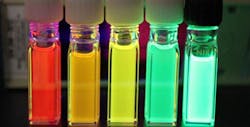Nanocrystal atoms cooperate like biomolecules, making better photonic devices possible
Champaign, IL--University of Illinois at Urbana-Champaign chemists have found that in addition to being similar in size, biological molecules and synthetic nanocrystals share an additional trait: they are reactive, meaning that atoms in a nanocrystal can cooperate with each other to facilitate binding or switching, a phenomenon widely found in biological molecules. The finding could catalyze manufacturing of nanocrystals for smart sensors, solar cells, tiny transistors for optical computers, and medical imaging. Led by chemistry professor Prashant Jain, the team published its findings in Nature Communications.
"In geological, industrial and domestic environments, the nanoscale grains of any material undergo chemical transitions when they are put under reactive conditions," Jain said. "Iron rusting over time and diamond forming from carbon are examples of two commonly occurring transitions. Understanding how these transitions occur on the scale of the tiniest grains of the material is a major motivation of our work."
Scientists can exploit such transitions to make nanocrystals that conform to a particular structure. They can make a nanocrystal of one material and transform it into another material, essentially using the original nanocrystal framework as a template for creating a nanocrystal of the new material with the same size and shape. This lets researchers create nanocrystals of new materials in shapes and structures they may not be able to otherwise.
In the new study, the researchers transformed tiny crystals of the material cadmium selenide to crystals of copper selenide. Copper selenide nanocrystals have a number of interesting properties that can be used for solar energy harvesting, optical computing, and laser surgery. Transformation from cadmium selenide creates nanocrystals with a purity that is difficult to attain from other methods.
The researchers, including graduate student Sarah White, used advanced microscopy and spectroscopy techniques to determine the dynamics of the atoms within the crystals during the transformation and found that the transformation occurs not as a slow diffusion process, but as a rapid switching thanks to cooperation.
The researchers saw that once the cadmium-selenide nanocrystal has taken up a few initial copper "seed" impurities, atoms in the rest of the lattice can cooperate to rapidly swap out the rest of the cadmium for copper. Jain compares the crystals to hemoglobin, the molecule in red blood cells that carries oxygen. Once one oxygen molecule has bound to hemoglobin, other binding sites within hemoglobin slightly change conformation to more easily pick up more oxygen. He posits that similarly, copper impurities might cause a structural change in the nanocrystal, making it easier for more copper ions to infiltrate the nanocrystal in a rapid cascade.
Now, Jain's team is using its advanced imaging to watch transitions happen in single nanocrystals, in real time. "We have a sophisticated optical microscope in our lab, which has now allowed us to catch a single nanocrystal in the act of making a transition," Jain said. "This is allowing us to learn hidden details about how the transition actually proceeds. We are also learning how one nanocrystal behaves differently from another."
Next, the researchers plan to explore biomolecule-like cooperative phenomena in other solid-state materials and processes. For example, cooperation in catalytic processes could have major implications for solar energy or manufacturing of expensive specialty chemicals.
SOURCE: University of Illinois at Urbana-Champaign;http://news.illinois.edu/news/13/1216nanocrystal_PrashantJain.html
About the Author

Gail Overton
Senior Editor (2004-2020)
Gail has more than 30 years of engineering, marketing, product management, and editorial experience in the photonics and optical communications industry. Before joining the staff at Laser Focus World in 2004, she held many product management and product marketing roles in the fiber-optics industry, most notably at Hughes (El Segundo, CA), GTE Labs (Waltham, MA), Corning (Corning, NY), Photon Kinetics (Beaverton, OR), and Newport Corporation (Irvine, CA). During her marketing career, Gail published articles in WDM Solutions and Sensors magazine and traveled internationally to conduct product and sales training. Gail received her BS degree in physics, with an emphasis in optics, from San Diego State University in San Diego, CA in May 1986.
